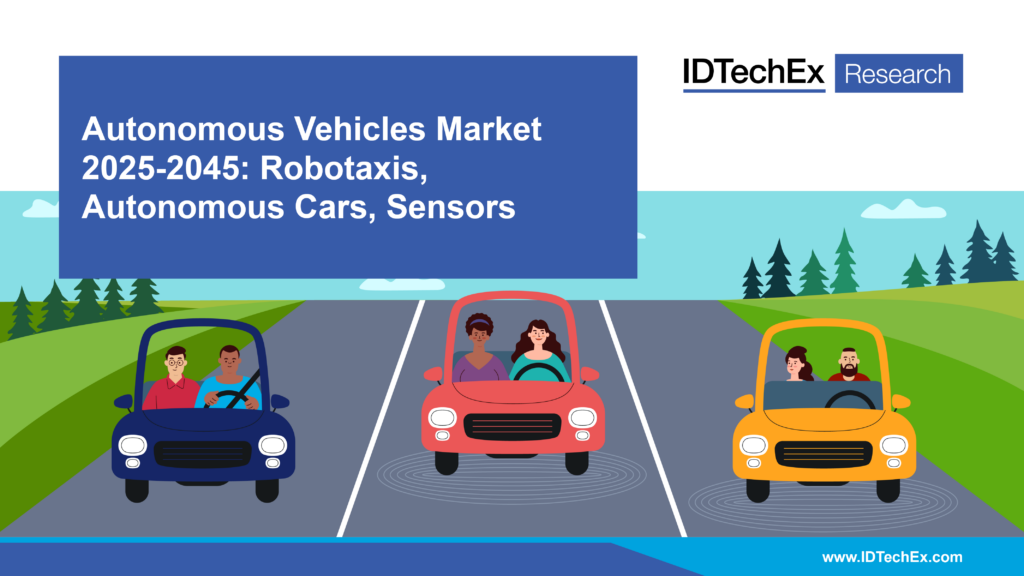For more information, visit https://www.idtechex.com/en/research-report/autonomous-vehicles-market-2025-2045-robotaxis-autonomous-cars-sensors/1045.
The global robotaxi vehicle market value in 2045 will be US$174 billion, growing with a 20-year CAGR of 37% between 2025 and 2045 and with a market share dominated by leaders from the US and China, such as Google’s Waymo, GM’s Cruise, WeRide, Baidu, and AutoX.
 IDTechEx’s Autonomous Vehicles Market Forecast
IDTechEx’s Autonomous Vehicles Market Forecast
The rise of level 2+ availability
For many years the term level 2+ has been used to describe high component level 2 ADAS systems that provide a well-refined highway assist experience, with smooth lane cantering abilities and robust adaptive cruise control. It has now become a solid stepping stone between level 2 and level 3 with the plus signifying that drivers can take their hands off the wheel while still monitoring the road.
 Miles of mapped roads where level 2+ hands-off, eyes-on driving is available from different OEMs.
Miles of mapped roads where level 2+ hands-off, eyes-on driving is available from different OEMs.
Over the past few years the availability of hands-free driving in the private car market has grown significantly. The market has been established since 2017 with early Super Cruise systems from General Motors. In 2024 General Motors has more than 20 models with Super Cruise available and is expanding to 750,000 miles of mapped roads to use the system on. Ford also has made a significant milestone by being the first OEM to offer level 2+ across Europe with its BlueCruise system. This report covers the full extent to which companies are offering level 2+ hands-off, eyes-on technologies, how many miles they are available on, and the laws and rules around level 2+ deployment in each region.
Level 3 struggling
The key difference between level 2+ and level 3 is that eyes-on becomes eyes-off. This effectively means that the OEM becomes liable for anything that happens while the vehicle is reporting that it is operating at level 3. So far, the only OEMs happy to accept this have been Mercedes and BMW, the former having certified level 3 driving in Germany, California, and Nevada, and the latter only having the technology in Germany.
Level 3 has been allowed on the roads since 2021, with a very small deployment from Honda in Japan. Following that, Mercedes certified its system in Germany in 2022, then in the US in 2023. Since then BMW has been certified in Germany and Mercedes has announced intentions to raise its maximum operating speed from 60kph (~40mph) to 95kph (~60mph). By the end of 2024, IDTechEx had expected to see more regions getting level 3 certification and more companies, especially GM and Ford, certifying their technologies. Progress has been much slower than initially thought, something that is reflected in IDTechEx’s forecasts. IDTechEx now sees level 2+ as a more significant avenue of development, with level 3 likely to pick up in a few years time.
Given the slow start that level 3 vehicles have had, IDTechEx now thinks their deployment and adoption will be much slower than initially predicted. See the full report for the technologies available on these vehicles, all the rules surrounding level 3 deployment, and IDTechEx’s predictions for how level 3 technologies will spread.
Robotaxis about to enter a significant growth phase
The robotaxi market is coming of age, with multiple commercial driverless robotaxi services coming online across the US and China in the past couple of years. Key players in these regions such as Google’s Waymo, GM’s Cruise, Baidu’s Apollo Go, and Amazon-backed Zoox, have now accumulated tens of millions of miles of real-world driving. Between them, these companies now have more than 2,000 robotaxis on the road, collecting data to fuel AI drivers, proving autonomous drivers can drive safely, and serving mobility as a service customers. For example, in Wuhan, Baidu has 500 robotaxis serving customers, hoping to scale to 1,000 by the end of 2024.
Now that commercial driverless robotaxi services have become established, IDTechEx expects at least a handful of new provider and location combinations to come online each year; for example, Waymo has already been confirmed in Austin and Atlanta. In the US and China this will soon build to a flurry of cities and services, with IDTechEx expecting the sale of robotaxi vehicles to reach US$174 billion in 2045, representing a 37% CAGR from 2025.
In addition to the US and China, IDTechEx expects driverless robotaxi services in Europe and Japan to begin soon, see the full report for when.
This report gives details of all the main robotaxi deployments, including fleet numbers and service area in square miles. IDTechEx tracks which cities have had commercial robotaxi deployments, analyzes the data and provides a 20-year forecast for the emergence of fully autonomous robotaxi services.
 Over US$100 billion of funding has gone into the mobility and autonomous vehicles over the past decade.
Over US$100 billion of funding has gone into the mobility and autonomous vehicles over the past decade.
Dr. James Jeffs
Principal Technology Analyst, IDTechEx
Dr. Xiaoxi He
Research Director, Topic Lead, IDTechEx
John Li
Technology Analyst, IDTechEx


